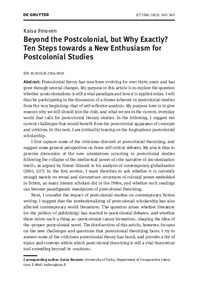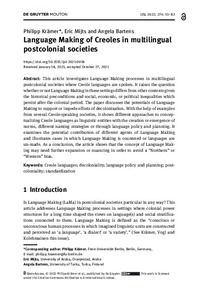Depictions of the Land and Nature: Postcolonial–Ecocritical Reading of Ngugi’s The River Between
Temonen, Joonas (2022-08-23)
Depictions of the Land and Nature: Postcolonial–Ecocritical Reading of Ngugi’s The River Between
Temonen, Joonas
(23.08.2022)
Julkaisu on tekijänoikeussäännösten alainen. Teosta voi lukea ja tulostaa henkilökohtaista käyttöä varten. Käyttö kaupallisiin tarkoituksiin on kielletty.
avoin
Julkaisun pysyvä osoite on:
https://urn.fi/URN:NBN:fi-fe2022091659428
https://urn.fi/URN:NBN:fi-fe2022091659428
Tiivistelmä
In my thesis, I discuss how Ngugi wa Thiong’o uses nature to perform social critique and as a symbolic tool in his novel The River Between. I analyse the novel as postcolonial literature, using the theoretical framework of postcolonial ecocriticism to analyse how nature is depicted in Ngugi’s work. I use Huggan and Tiffin (2010) as my most important theoretical source, as it directly discusses postcolonial ecocriticism. In my thesis, I also discuss the social, cultural and political context behind the events of The River Between, and touch upon Ngugi’s personal life as a source of inspiration for his works.
In the analysis, I discuss the different depictions of nature and how Ngugi’s critique and symbolism is present in those. The elements of nature that I analyse are the two ridges upon which the villages are built, the land of the Gikuyu, the Sacred Grove present in the novel, Mount Kerinyaga (Mount Kenya), the Honya River, and the sun.
In my analysis I argue that Ngugi uses the depictions related to the land serve as critique towards colonization. Ngugi is criticising colonialism and the loss of culture and disunity it created for the Gikuyu. I also present two different arguments: one arguing for the existence of hybrid thoughts, and another which is direct critique against them, arguing that hybridity in itself denotes submissiveness towards colonization. I also argue that the depictions of the river and the sun are mainly critique against unicentricity, which is reoccurring in Ngugi’s works.
In the analysis, I discuss the different depictions of nature and how Ngugi’s critique and symbolism is present in those. The elements of nature that I analyse are the two ridges upon which the villages are built, the land of the Gikuyu, the Sacred Grove present in the novel, Mount Kerinyaga (Mount Kenya), the Honya River, and the sun.
In my analysis I argue that Ngugi uses the depictions related to the land serve as critique towards colonization. Ngugi is criticising colonialism and the loss of culture and disunity it created for the Gikuyu. I also present two different arguments: one arguing for the existence of hybrid thoughts, and another which is direct critique against them, arguing that hybridity in itself denotes submissiveness towards colonization. I also argue that the depictions of the river and the sun are mainly critique against unicentricity, which is reoccurring in Ngugi’s works.
Samankaltainen aineisto
Näytetään aineisto, joilla on samankaltaisia nimekkeitä, tekijöitä tai asiasanoja.
-
Language Making of Creoles in multilingual postcolonial societies
Krämer Philipp; Bartens Angela; Mijts Eric<p>This article investigates Language Making processes in multilingual postcolonial societies where Creole languages are spoken. It raises the question whether or not Language Making in these settings differs from other ... -
Negotiating positionality amid postcolonial knowledge relations: insights from Nordic-based Sub-Saharan African academics
Ezechukwu Gabriel U.This article is concerned with the issue of positionality in the context of transnational academic career. Focusing on the views and experiences of Nordic-based Sub-Saharan African academics, the paper adopts a transcolonial ...



